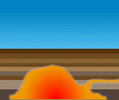

Igneous intrusions are masses of rock formed
when magma cools beneath the surface. They rise to the surface
because they are less dense
than the surrounding rock. When a magma within the crust loses
its mobility and slowly cools and solidifies it forms a mass of
igneous rock called an intrusion. Igneous intrusions become exposed
on the Earth's surface when the previously overlying rock surface
has been removed by erosion. They are classified according to
their sizes, shapes, and
relationships to the older rocks that surround them. Some common
intrusive rocks are batholiths, stocks, dikes, sills, and laccoliths.
Batholiths are large masses of coarsely crystalline
rock (usually granitic composition) that cool in the magma chamber.
They are found almost exclusively in continents and large island
arcs, and do not occur in oceanic islands. They form in the deeper
zones of mountain belts and
are exposed after considerable uplift and erosion. They are the
largest rock bodies on Earth and can cover several thousand square
kilometres. They appear to be huge, slablike bodies, with a horizontal
extent much greater than their thickness. It is suggested (still
unknown) that they
were emplaced at depths of more than 7km below the surface. Areas
of
extensive exposure of batholiths are considered to be the roots
ofancient mountain ranges, which have long since been eroded to
lowlands.
Stocks are an intrusive rock mass with an outcrop
(an exposed area atthe surface) of less than 10 kilometres squared.
Some stocks are knownto be small protrusions rising from the main
batholith, but much is unknown. A stock is generally composed
of granitic rock, and many
are porphyritic (air spaces) with a fine grained groundmass. Many
deposits of silver, gold, lead, zinc, and copper are found in
fractures and form veins extending from a stock into the surrounding
rock.

